| | Integrated pest management | Guide to pest insects | Guide to beneficial insects
This field guide was prepared to enable growers of seed alfalfa to quickly identify their pest and beneficial insects.
The important distinguishing features are indicated on the plates by arrows. These features can be readily seen with a hand lens or magnifying glass.
Economic thresholds are based on the average number of insects captured in five 90o sweeps. (Figure 1).
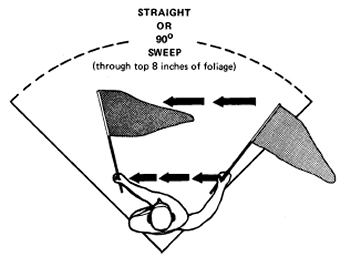
Figure 1. How to make a sweep |
Integrated pest management
Alfalfa seed growers must manage the insect pest populations to obtain increased seed production while simultaneously protecting pollinators and other beneficial insects. Towards this end, an alfalfa integrated pest management program has been established.
The major goal of this program is to combine biological, chemical and cultural pest insect control methods with management practices that allow the beneficial insect populations to increase.
Guide to Pest Insects
| Immature lygus bug (nymph)
Description
- up to 4 mm in length
- usually light green with black spots on the back (arrow)
- nymph stage 1, 2, 3 - no wing pads (top row, Figure 2)
- nymph stage 4, 5 - wing pads (middle row, Figure 2)
- nymph stages scamper from net absence of cornilles (contrast with aphids)
Damage
- feed on buds
- suck juice out of developing seeds
Evidence
- buds turn white
- flowers drop
- no bloom
- seeds brown and papery thin
Generation
Economic threshold
- nymph stage 1, 2, 3 - fifteen per sweep
- bud and bloom - nymph stage 4, 5 - two or three per sweep
- after bloom - nymph stage 4, 5 - four per sweep
| 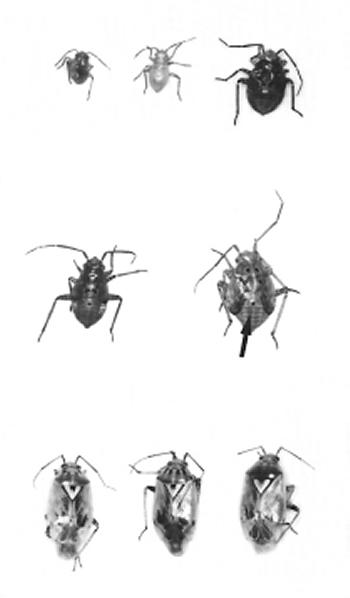
Figure 2. Lygus bugs |
| Adult lygus bug
Description
- 4-5 mm in length
- brown lygus - pale yellow to brown with darker brown, black and red markings
- green lygus - pale green with some portions bright green
- last two segments of antennae of equal length and the same color
- a distinctive "V" mark on the back
- body shorter and broader than alfalfa plant bug (bottom row, Figure 2)
Damage
- feed on buds
- suck juice out of developing seeds
Evidence
- buds turn white
- flowers drop
- no bloom
- seeds brown and papery thin
Generation
Economic threshold
- bud and bloom - 2-3 per sweep
- after bloom - 4 per sweep
|  |
 |
|
| Immature alfalfa plant bug (nymph)
Description
- up to 5 mm in length
- usually dark green
- no spots on the back
- nymph stage 1, 2, 3 - no wing pads (top row, Figure 3)
- nymph stage 4, 5 - wing pads (rows 2, 3, Figure 3)
- nymph stages walk from net
- antennae with last segment enlarged and dark (arrow)
- absence of cornicles (contrast with aphids)
Damage
- feed on buds
- suck juice out of developing seeds
- inject toxin
Evidence
- buds turn white
- flowers drop
- no bloom
- seeds brown to black and papery thin
Generation
Economic thresholds
- nymph stage 1, 2, 3 - fifteen per sweep
- bud and bloom - nymph stage 4, 5 - two or three per sweep
- after bloom - nymph stage 4, 5 - four per sweep
Adult alfalfa plant bug
Description
- 8-9 mm in length
- yellowish-green
- segments two and three of antennae of equal length, dark areas on three and four
- body long and thin (bottom row, Figure 3)
Damage
- feed on buds
- suck juices out of developing seeds
Evidence
- buds turn white
- flowers drop
- no bloom
- seeds brown to black and papery thin
Generation
Economic threshold
- bud and bloom - 2-3 per sweep
- after bloom - 5 per sweep
| 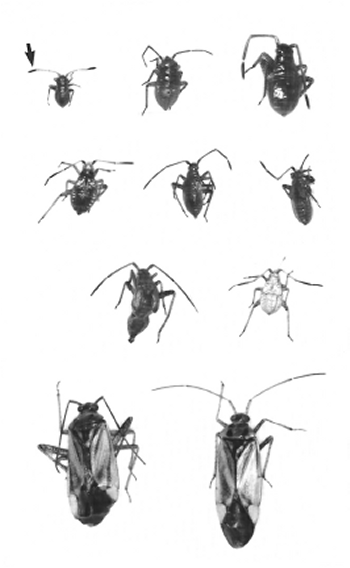
Figure 3. Alfalfa plant bug. The insect in the top row centre is a lygus bug inserted for comparison. |
| Immature pea aphid (nymph)
Description
- up to 3 mm in length
- light to dark green
- soft-bodied, pear-shaped
- cornicles on abdomen (arrow) (middle row, Figure 4)
- remain in net
Damage
- suck juice from plants
- stunt growth
Evidence
Generation
- several generations per year
- young born alive, resembling adult
Economic threshold
| 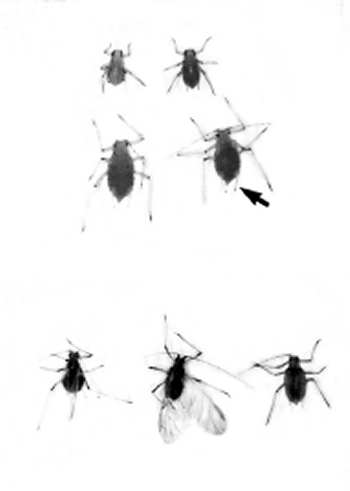
Figure 4. Pea aphid |
| Immature alfalfa weevil (larva)
Description
- up to 8 mm in length
- head capsule black
- instar 1, 2 - light brown to brown (top row, Figure 5)
- instar 3, 4 - green with white line down middle of back (middle row, Figure 5)
- worm-like (actually legless)
Damage
- feed on developing buds
- feed on leaves
- stunt growth
Evidence
- "shot holes" in leaves
- field has a silvery sheen
- no bloom
Generation
Economic threshold
Adult alfalfa weevil
Description
- 3-5 mm in length
- spring adults - dark grey to black
- summer adults - dark brown with a conspicuous dark stripe extending 3/4 way down middle of back
- weevil-like (bottom row, Figure 5)
Damage
- feed on buds
- feed on leaves
- stunt growth
Evidence
- large holes in leaves
- no bloom
- field has silvery sheen
Generation
Economic threshold
| 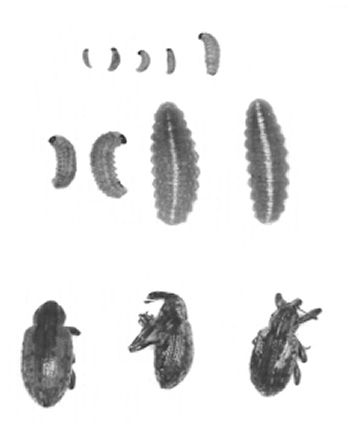
Figure 5. Alfalfa weevil |
| Guide to Beneficial Insects |  |
Immature damsel bug (nymph)
Description
- up to 8 mm in length
- greyish
- resemble adults (top row, Figure 6)
Benefit and prey
- feed on aphids, immature lygus and plant bugs
- will sometimes feed on small alfalfa weevil larvae
Generation
Adult damsel bug
Description
- 8 mm in length
- greyish brown (bottom row, Figure 6)
Benefit and prey
- feed on aphids, immature lygus and plant bugs
- will sometimes feed on small alfalfa weevil larvae
Generation
| 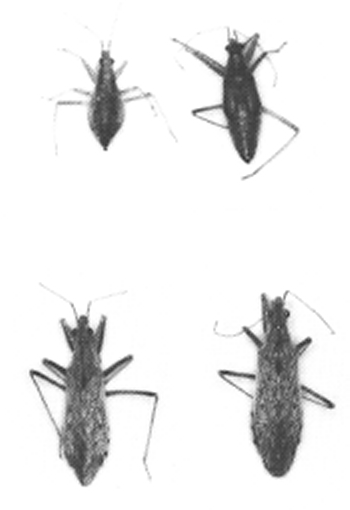
Figure 6. Damsel bug |
| Immature ladybird beetle (larva)
Description
- up to 12 mm in length
- marked with blues, blacks, oranges
- somewhat flattened
- resemble small "alligators" (top row, Figure 7)
Benefit and prey
- voracious appetite
- will consume about 25 aphids per day
Generation
- several generations per year
Adult ladybird beetle
Description
- 4 to 6 mm in length
- usually red, orange or yellow
- wings covered with different arrangements of black spots (bottom row, Figure 7)
Benefit and prey
- consumes up to 25 aphids per day
- must consume 120 aphids before egg laying
- will consume three aphids for each egg laid
- deposits about 1,500-1,700 eggs during the summer
Generation
- several generations per year
| 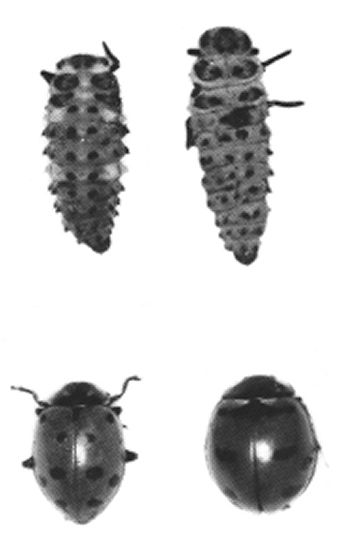
Figure 7. Ladybird beetle |
| Immature green lacewing (larva)
Description
- up to 9 mm in length
- usually mottled grey with yellowish grey
- larvae "alligator like" with distinct sickle-shaped mandibles (jaws) that pierce and suck juice from their prey (top row, plate 8)
Benefit and prey
- feed on aphids, immature lygus and plant bugs
Generation
Adult green lacewing
Description
- up to 20 mm in length
- wingspan over 30 mm in length
- entirely green (bottom row, Figure 8)
- long antennae
- four delicate, lacy wings
- pungent odor when caught
Benefit and prey
- feed on aphids and other soft-bodied insects
- also feed on honeydew, plant nectar and pollen
Generation
| 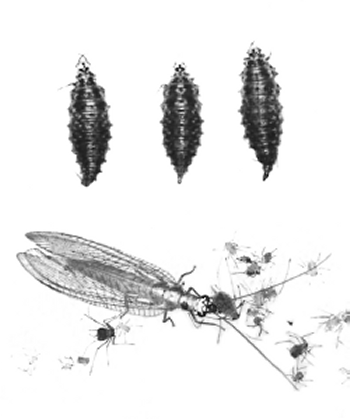
Figure 8. Green lacewing |
| Immature minute pirate bug (nymph)
Description
- up to 2 mm in length
- nymph stage 1, 2, 3 - yellowish to reddish orange
- nymph stage 4, 5 - black and white and resemble adult
- body somewhat flattened (top row, Figure 9)
Benefit and prey
- feed on aphids and other small soft-bodied insects
Generation
Adult minute pirate bug
Description
- 1.5-2 mm in length
- black and white
- head with a very prominent beak (bottom row, Figure 9)
Benefit and prey
- feed on aphids, mites and other small soft-bodied insects
Generation
|
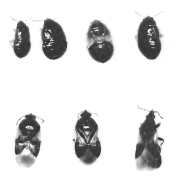
Figure 9. Minute pirate bug
|
| Immature common syrphid fly (larva)
Description
- up to 8 mm in length
- color varies from brown to yellowish or green with white lines down back. Distinguished from alfalfa weevil larva by not having a black head capsule (see immature alfalfa weevil)
- slug-like, rounded at rear, pointed at front (top row, Figure 10)
- spiny hair-like structures on body
Benefit and prey
- 400 aphids consumed by larva during its developmental period
Generation
- several generations per year
Adult common syrphid fly
Description
- 4-6 mm in length
- abdomen marked with yellow, black or white bands
- flies like a mini-helicopter, hovering over flowers
- resembles small bee or wasp (bottom row, Figure 10)
Benefit and prey
- larvae feed on aphids
- adults feed on honeydew, plant nectar and pollen
Generation
- several generations per year
|
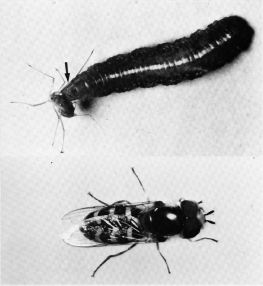
Figure 10. Common syrphid fly
|
| Immature big-eyed bug
Description
- up to 5 mm in length
- buff grey or blackish
- very large eyes and buff color distinguishes them from lygus and alfalfa plant bug nymphs. Resembles adult.
Benefit and prey
- feed on aphids, immature lygus and alfalfa plant bugs
Generation
|  |
| Adult big-eyed bug
Description
- 3-5 mm in length mostly buff grey or blackish
- very prominent large eyes (Figure 11)
Benefit and prey
- feed on aphids, immature lygus and alfalfa plant bugs
Generation
|
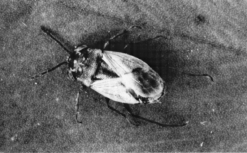
Figure 11. Adult big-eyed bug
|
Prepared by:
B.D. Schaber
Agriculture Canada
Lethbridge Research Station, Lethbridge, Alberta
Source: Agdex 121/620-1. |
|